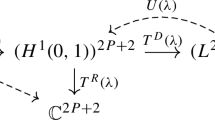Abstract
In order to solve the problem of truncating the open boundaries of cylindrical waveguides used in the simulation of high power microwave (HPM) sources, this paper studies the convolutional PML (CPML) in the cylindrical coordinate system. The electromagnetic field’s FDTD equations and the expressions of axis boundary conditions are presented. Numerical experiments are conducted to validate the equations and axis boundary conditions. The performance of CPML is simulated when it is used to truncate the cylindrical waveguides excited by the sources with different frequencies and modes in the 2.5-dimensional problems. Numerical results show that the maximum relative errors are all less than −90 dB. the CPML method is introduced in the 2.5-dimensional electromagnetic PIC software, and the relativistic backward wave oscillator is simulated by using this method. The results show that the property of CPML is much better than that of the Mur-type absorbing boundary condition when they are used to truncate the open boundaries of waveguides. The CPML is especially suitable for truncating the open boundaries of the dispersive waveguide devices in the simulation of HPM sources.
Similar content being viewed by others
References
Barker, R. J., Schamiloglu, E., High Power Microwave Sources and Technology, New York: IEEE Press, 2001.
Wang Jianguo, Liu Guozhi, Zhang Dianhui, PIC method for numerical simulation of HPM sources, Test and Research, 2003, 26(1): 97–104.
Mur, G., Absorbing boundary conditions for the finite-difference approximation of the time-domain electromagnetic-field equations, IEEE Trans. Electromagn. Compatibility, 1981, 23(4): 377–382.
Tarakanov, V. P., User’s Manual for Code Karat, Moscow: Aug. 2001.
Wang, Y., Wang, J. G., Zhang, D. H., Application of CPML to Truncate the Open Boundaries of 3D Rectangular Waveguides, High Power Laser and Particle Beams, 2005, in print.
Bérenger, J. P., A perfectly matched layer for the absorption of electromagnetic waves, J. Comput. Phys., 1994, 114(2): 185–200.
Roden, J. A., Gedney, S. D., Convolutional PML (CPML): An efficient FDTD implementation of the CFS-PML for arbitrary media, Microw. Opt. Tech. Letters, 2000, 27: 334–339.
Author information
Authors and Affiliations
Corresponding author
Rights and permissions
About this article
Cite this article
Wang, Y., Wang, J. & Zhang, D. Application of CPML to truncate the open boundaries of cylindrical waveguides in 2.5-dimensional problems. Sci China Ser F 48, 656–669 (2005). https://doi.org/10.1360/04yf0186
Received:
Issue Date:
DOI: https://doi.org/10.1360/04yf0186




